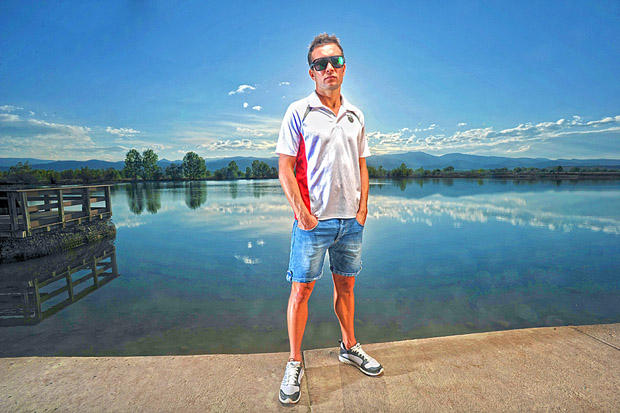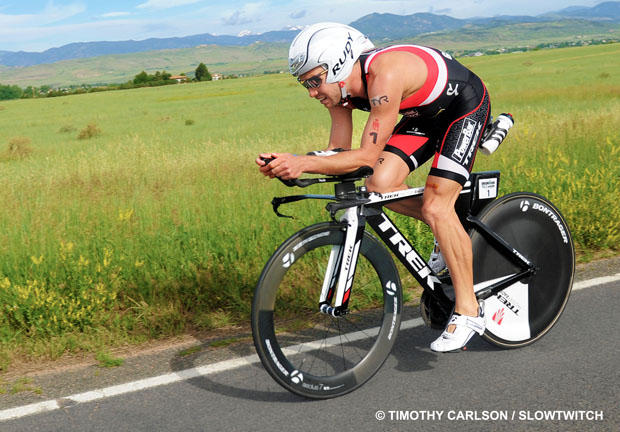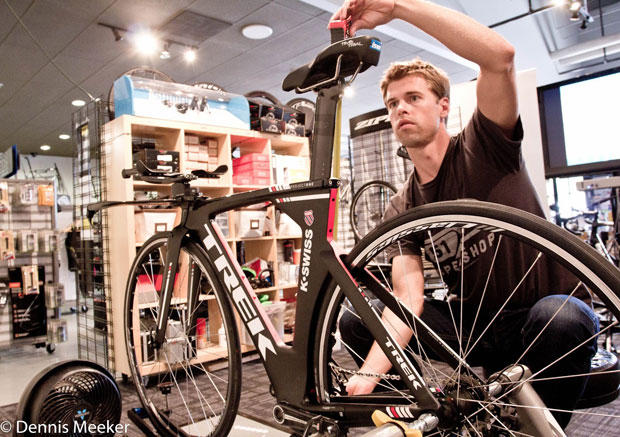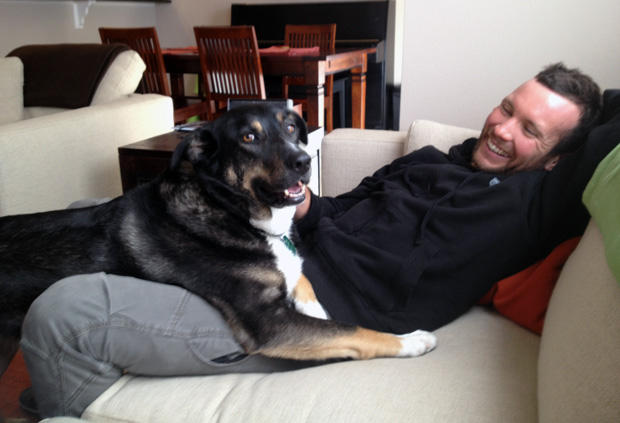Joe Gambles is all in for 2014
Joe Gambles has one of the finest résumés in triathlon. He has 15 professional victories including a silver medal at the 2011 ITU long distance world championship, a bronze at the 2013 Ironman 70.3 World Championship, a four-peat at Boulder 70.3 and a victory in his Ironman debut at Wisconsin in 2010. He has set 10 course records at top half Ironman venues such as Boulder, Quassy, Timberman and Syracuse.
And at age 32, in his 16th year of triathlon, he is hungry to see where his enormous talent can take him. In his baptism on the lava fields at Kona three years ago he came off the bike near the lead but faded to 20th. Better prepared in his quest at the prestigious Ironman Melbourne in 2012, he got off the bike second then held on for 8th. Now, under the guidance of coach Neal Henderson, Gambles is putting all his chips on the table in a quest to score at the sport’s biggest Ironman distance and half Ironman races. Cutting his usual race schedule in half to six topflight races, he has set up a season-long build that will culminate with no-excuse efforts at Challenge Roth, Ironman 70.3 Worlds in Mt. Tremblant and a rematch at the Ironman World Championship in Kona.
And then, after a Maui wedding with fiancée Sage Calamari, he hopes to race for a share of the $500,000 purse at Challenge Bahrain.
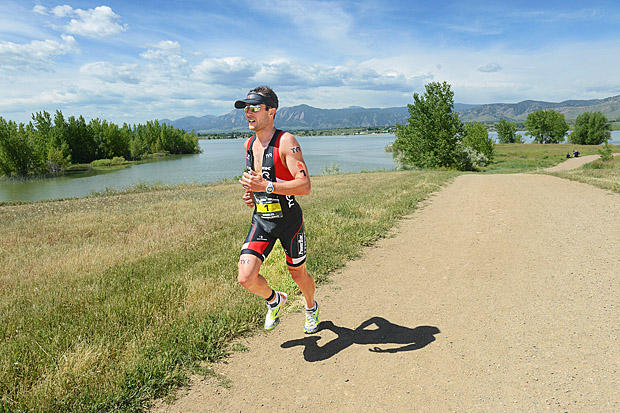
Slowtwitch: Tell us about Tasmania, the Australian island south of the mainland.
Joe Gambles: I am from Launceston, the second largest city in Tasmania and one of the oldest in Australia. A lot of the really hardened criminals were sent from England to settlements in Australia and Tasmania. But I was actually born in England, so I wasn't a convict. Just to make that clear.
ST: What do you know about the famous Tasmanian devil?
Joe: They are animals unique to Tasmania who are in danger of extinction, because in the last few years they got a facial tumor disease that has spread and wiped out 80 percent of the population.
ST: Are they a threat to babies and dogs?
Joe: No threat. They are scavengers who basically come out at night. They might eat a wallaby or a kangaroo or wombat that died. They are nature’s garbage disposal units.
ST: I hear there is a very powerful, nasty surf spot in Tasmania?
Joe: It is called Devil’s Point at Shipstern Bluff. They have one of the big wave tournaments there every year. There is no easy entry or exit point, so surfers get jet-skied or helicoptered in. I have a friend that actually surfs there. But it is definitely not for me.
ST: How do folks make a living there?
Joe: Agriculture is big. Tourism is always growing. Hobart is the biggest city and is the driver of the economy. There are a lot of cows and dairy. We are surrounded by water so a lot of fishing obviously. We export a lot of salt water salmon to Japan. And we build catamarans and export them to Europe.
ST: What is the general character of Tasmanians?
Joe: Very down to earth. We don't put up with any crap in Tasmania. It is true of Australia as well. We like people to be who they are and do not put on any show. We work hard and love life.
ST: Is that why you admire Craig Walton?
Joe: He is Tasmanian. I love the way he raced from the front. When drafting came into the ITU style racing, he didn’t change anything. He just put his head down and tried to rip the legs off everyone and he won many big races in America and around the world. I had the privilege of training with him a little bit and spending some time with him. He is a really nice guy and a real asset to the sport.
ST: Tell us about your parents.
Joe: My mum Mary is a social worker. My dad Paul started as a teacher who later worked rehabilitating brain injured people and worked in the social services as well.
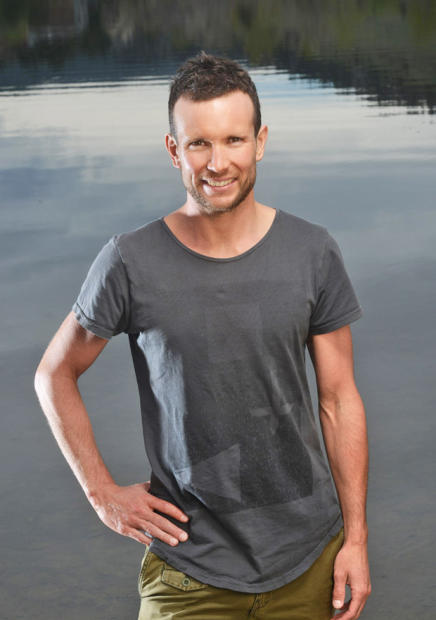
ST: Tell us about your win at Boulder 70.3. How were you doing leading up to this race?
Joe: This year I cut my schedule down to six big races, targeting Challenge Roth, the Ironman 70.3 World Championship at Mt. Tremblant and Kona.
ST: No smaller races?
Joe: Yep. This was my year to race big races and test myself against the best in the world. I started at Oceanside 70.3 [4th] and at St. George 70.3 [4th]. Boulder 70.3 wasn't on my schedule to start with. I was going to defend my title at Rev 3 Quassy — but they pulled the pro purse there, which is a shame. So I decided to stay home and race here and I am glad I did. Coming into this race I felt I had a lot to lose. I had won three straight times and I was going for four and the field was strongest I'd faced.
ST: What was your strategy?
Joe: My riding has been better than ever. I was going for the win and the best way to race was to put the pressure on the bike as I'm probably going to run as quick as anyone off a fast bike. I got a bigger lead than I expected. [4 minutes.], so I managed to hold on, even though I had a pack of seven guys chasing me and on the run, I held off Tim Don.
ST: What do you need to improve?
Joe: Last year, I got 3rd at [the Ironman 70.3 World championship in Las] Vegas and I was really happy. Then I went to Ironman Tahoe and I got third.
ST: Things were going well – so why did you decide to sign on with Neal Henderson?
Joe: I have been self-coached most of my career. But I was really struggling to improve my bike. It seems as if everyone is a good biker now. I needed to improve for the Ironman distance and I just kept mulling over what I should do. Should I increase my miles? My intensity? How do I piece it all together? I didn’t know how, so I thought I better go with someone who does.
ST: Neal has done great work with Cameron Dye.
Joe: Cam is an amazing cyclist. He could hold his own against professionals. He is the real deal. And Neal is a true professional. I thought I knew a lot about training myself and coaching, but I knew nothing compared to Neal. I trust him completely.
ST: Neal also coaches Taylor Phinney. What of Neal’s experience coaching world class cyclists applies to a triathlete?
Joe: More than I thought. While pro cyclists are training for time trials and road racing, that does carry over a lot. At least once a week I am training with professional cyclists. Now that I am focusing on Ironman, I’m doing even more high intensity than I ever thought I would.
ST: How do you combine high intensity and long rides?
Joe: Neal’s philosophy — and the same with Grant Holicky, who is in charge of the swim program with Neal at Apex Coaching — is all about developing the ability to call upon higher levels of output when necessary. It’s about being able to develop 1st, 2nd, 3rd, 4th and 5th gears. By contrast, many endurance athletes are very good staying at a solid pace all day but they might have only 2 or 3 gears. To win races now, you need to be able increase your output on demand. At the start of the swim, you need to be able to go out fast with the front pack. Then you need to surge at the end of the swim to make the lead pack starting the bike. And at Kona, you need to respond to a lot of surges in the first 20 or 30 miles of the bike.

ST: How does that work?
Joe: At times, you need to shift gears and step up to Olympic distance pace and then there are times when you are going quite steady. That is what I’ve been working on with Neal. In swimming, I am doing a lot more volume, a lot at higher intensity and taking a lot more rest. Same with the bike. I haven't done much with my run, which is more about staying injury-free and consistent. Obviously, you can push yourself a lot more on the bike because you’re not pounding your legs.
ST: What is different about the workouts you are doing with Neal?
Joe: I am doing a lot of high cadence work and a lot of sprints – really short 5- to 20-second sprints, often as part of a long bike ride.
ST: How have you adapted to this regimen?
Joe: The long rides do not seem hard now because we do so much high intensity work at other times. Ironman pace now is only tempo and doesn’t seem difficult. Whereas when I wasn’t doing higher intensity work, Ironman pace was the hardest training I was doing.
ST: Have you done workouts with Taylor Phinney?
Joe: I never met Taylor Phinney, who has been away in Europe. The sessions that Neal is giving me are similar to what he has been giving Taylor, whom he’s been coaching since he was a teenager. Cam Dye is the man I have been training with mainly. You watch him and you understand why he comes off the bike at Olympic distance races with such a lead. He takes people out of their comfort zone. Along the way, his rivals submit on the bike and their only chance with Cam is to try to run him down.
ST: Looking at your Ironman rides at Kona and Melbourne before working with Neal, what was missing?
Joe: The intensity. The biggest mistake I made was thinking that I just needed to do everything at Ironman pace.
ST: As a top cyclist, what do you think of drafting rules as they stand?
Joe: We don't want an ITU-style race. We race non-drafting because it is an individual sport. You don't want a pack of 15 finishing together at St. George so it comes down to a running race. That’s boring. You want an Andrew Starykowicz or Andrew Yoder coming off the bike with a 3 or 4 minute lead. Then you want a whippet-like Tim Don who must make up that time on him.
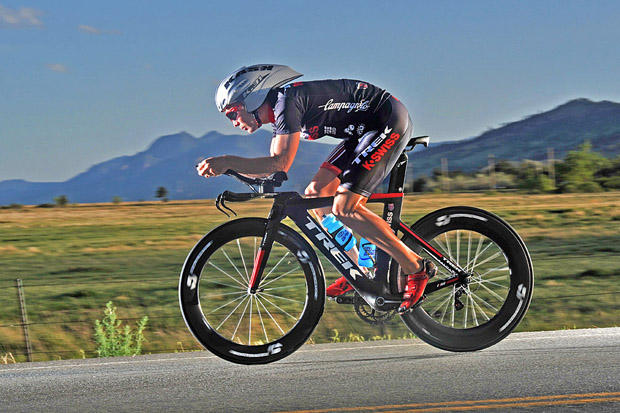
ST: Your race-winning scenario at Boulder 70.3 seemed to fit that prescription?
Joe: I came off the bike with 4 minute lead and it was an exciting race. That’s because Tim Don went out like it was an ITU 10 kilometer run and pulled 2 minutes on me in the first seven miles.
ST: He didn't have enough left to finish the deed?
Joe: He didn’t. But it was exciting. Weak cyclists are looking for a free ride now. Tighter officiating when people do, ‘accidentally’ as they say, drift into the draft zone will discourage people. They will sit further back, the packs will split — and you’ve got a more exciting race.
ST: Will this work at Kona?
Joe: The distance, the heat and humidity and the winds make for a bit longer draft zone there. Marshals use markers on the road to gauge the distance between bikes — which are 12 or 13 meters apart. With the crosswinds you are not getting the same comfortable distance between bikes. That’s why the riders split up in Kona.
ST: How was your first crack at Kona and Melbourne?
Joe: Not bad. I did my first Kona in 2011 – it was a fast year, the year Crowie broke the Kona record – and it was great. I rode about 4:30 [4:31:06]. But I had nothing left for my run [3:12:56]. So I headed backwards and got 20th.
ST: What happened at Melbourne in 2012?
Joe: I got off the bike second [4:27:46] with a group of guys that included Craig Alexander and Cam Brown and Frederik van Lierde. I ran [2:54:02] and finished 8th – which was decent.
ST: How did your run compare to Crowie’s?
Joe: Crowie ran 2:38:46. I got off the bike with the leaders and was running with Cam Brown and Craig Alexander for the first 8 kilometers. We had a tailwind and it was only 60 degrees so we were flying. After I fell back, they kept on flying. It was pretty amazing to watch.
ST: Why are you now a better Ironman athlete with an eye on the podium?
Joe: Since my first Kona, I got eight more 70.3 victories under my belt. The 70.3 is a really good distance for me and I race it well. But I don't know how long I will race. I completely believe in Neal’s coaching and I am moving in the right direction. So why not step up and test myself with the big boys?
ST: Are your sponsors happy with you doing fewer races?
Joe: The field at Oceanside 70.3 is the March world championship. St. George 70.3 was as good if not better than Vegas last year. And Boulder had one of the best 70.3 fields so far. Now Roth has its 30th anniversary and the pro fields are ridiculously strong. My sponsors love to see I am pushing limits and mixing it up with the best in the world. They don't want to see you shucking and jiving at races with a couple of pros.
ST: Some triathletes are afraid to go all in on just a few races?
Joe: I agree. But this year wasn't about making money. It was about believing in myself and racing the big races. I might not end up as financially well off this year. But I want to keep progressing with my career. We will see. If it doesn’t go well, maybe I will go back to racing 12 races a year. But if I do well in next three races, I won’t need to worry about racing for paychecks.
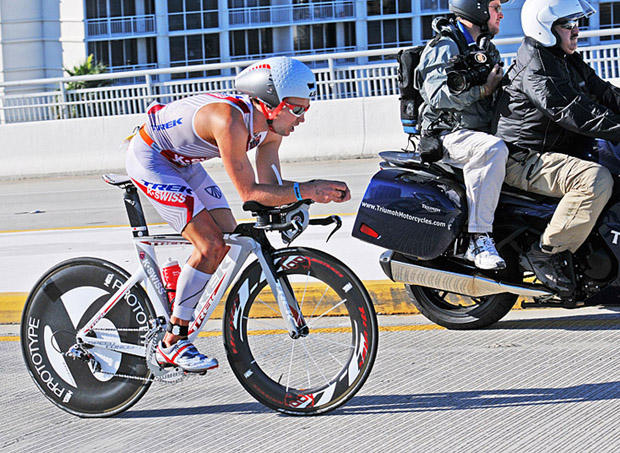
ST: Why Roth?
Joe: Hawaii is the one you hear about first as a young triathlete. Roth is the next one. Felix [Walchshöfer, the CEO] at Challenge is an amazing guy. I had the privilege of meeting him on holiday with my fiancée last October at Challenge Barcelona and we talked about coming to race Roth and he invited me to come and race. I get goose bumps thinking about it.
ST: Why?
Joe: The history, the crowds, the way the whole community embraces that event. And they treat the athletes so well. It is a beautiful part of the world and I am looking forward to drinking that beer at the finish line.
ST: How important is the Challenge series?
Joe: So important. Challenge puts on amazing events and it is growing all the time. They are expanding to America and they have two or three races in Australia. And now they’ve announced Challenge Bahrain with the biggest prize purse for the distance [twice the $250,000 Ironman 70.3 World Championship pro purse]. Challenge will fly you out and hotels that treat you like royalty if you make top three at Roth. So I’m going to make every effort to get to Bahrain and race – if I am still in one piece after this season.
ST: Do you have strategy for Roth?
Joe: I am going there to race the big boys of Ironman like Luke McKenzie and Dirk Bockel [and Pete Jacobs, Eneko Llanos, James Cunnama, Timo Bracht and Nils Frommhold] – all proven Ironman athletes. I’m going to swim and ride with them and then hope that I've got some legs left after they try to tear ‘em off.
ST: What do you think about the course?
Joe: I’ve heard about it. I think it’s about trying to control those steep uphills and just keep the power on those fast, long downhill bits. I am light compared to these big Ironman guys. So I will try to conserve energy on the long, slight downhills, where they will try to drop me. I am probably not on their radar at the moment. But if I am still there when we hit T2, they will probably start to worry about me.
ST: How fast can you run in an Ironman distance race?
Joe: I think the 2:54 splits I’ve done so far are not fast. It depends on what sort of shape you are getting off the bike. Of all the guys I'm racing at Roth – apart from Eneko Llanos — I’ve got the fastest 70.3 run split by quite a few minutes [1: 11:27 at Vineman 70.3.] I know a half marathon at a half Ironman is not the same as an Ironman run. But if I get off the bike in good shape, I can use my run form and economy to test these guys and beat them in the end.
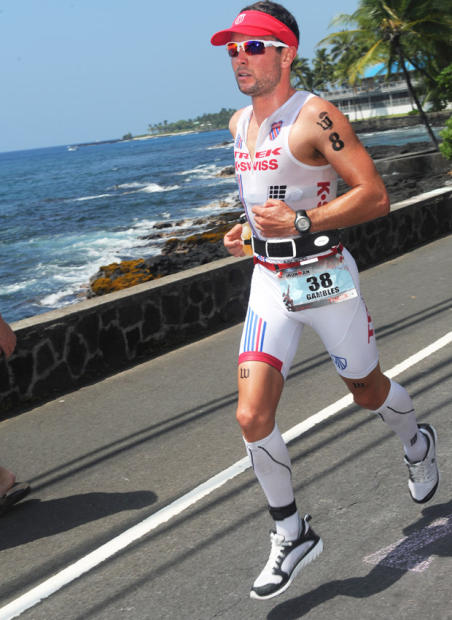
ST: How can super cyclists put together a run to win a big Ironman race?
Joe: A guy like Dirk Bockel doesn’t have the leg speed of the half Ironman guys. But at Melbourne this year, he ran at 6:20 per mile pace (2:46 marathon pace) and he ended up on top. If you are running 6:20 per mile pace all the way, you are flying compared to people who have gone out too fast and end up going backwards.
ST: How careful must you be about Ironman run pace?
Joe: I can hold the redline the whole way in a half Ironman run. But in an Ironman, you can be feeling great one minute, terrible the next. So you need to get through those tough sections. You can do it — if you have done the work.
ST: What mistakes did you make in the Ironman races you finished?
Joe: In my first year at Hawaii, I think I went in a little bit overdone. Vegas took it out of me and I didn't recover. I spent three weeks training in Hawaii before the race and just never got on top of it again.
ST: What did Neal advise you to try?
Joe: PAUSE. More is not always better. It’s more about getting in the quality sessions. Which means it is OK to ride very, very easy to recover and set yourself up for the key sessions. I used to run and ride too hard on the easy days and then never quite recovered enough to get the most out of my hard sessions. It is more of a balancing act now. On my easy days, I definitely ride easy. When I ride hard, I ride very hard. No more gray zone training. Those days are gone.
ST: How do you keep to your easy pace with other riders?
Joe: You have to have confidence in your program. Other people are probably wondering why I am riding so slow. And when we start an interval, they probably wonder why I am riding so fast. That’s the difference. It is easy to go on a 100 mile time trial and ride 22 miles an hour all day in Boulder. But it doesn't do anything for you. It makes you fit, but not race fit. I am not here to race in training. I am here to train to race.
ST: What is the value in recovery training at a reduced pace?
Joe: There is a lot of scientific research to validate that. It’s funny. I warm up with Cam Dye before a track workout. He is one of these guys who can literally get out of the car and start running 7 minute miles. I get dropped in the warm up before we start at the track. Then I start the workout and I am fine. It is definitely more pleasurable than running 7 minute miles straight out of the gate.
ST: The Boulder 70.3 run course has a lot of gravel and dirt. Was your 1:14 run better than it seemed?
Joe: Boulder is definitely not a fast run course. Tim Don breaking 1:12 on the run was exceptional. It is maybe half a mile that is on a sealed surface each lap while most of it is gravelly and loose dirt.
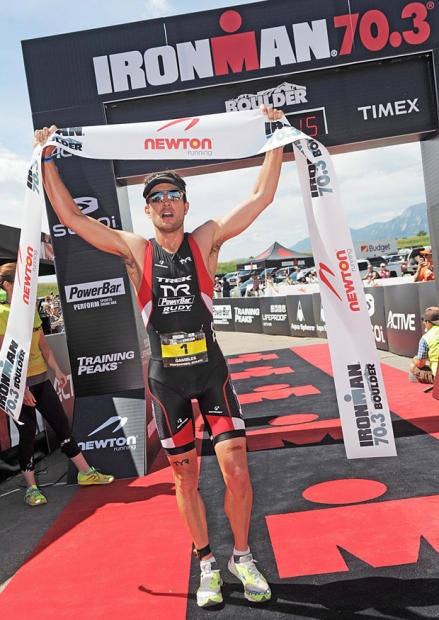
ST: You are engaged to the lovely Sage Calamari. How did you get so lucky?
Joe: It is true. She says she is with me for my accent.
ST: She is part Italian – I hear she cooks very well?
Joe: She does. That is why I am not quite as lean as last year.
ST: Ever fall prey to the thinking that you should be just be as light as possible – then end up getting sick or injured?
Joe: I don’t think I have ever been too lean. You have to have balance. You can be too lean and get sick and injured. So you have to find what works for you. I never limit my calorie intake. I eat as much good quality food as I want and let the training and everything else balance out.
ST: Do you keep a strict diet?
Joe: I am not scared of falling off my diet. I have a beer or a glass of wine last night. So if I feel like chocolate I will have chocolate. I just eat well.
ST: No huge bags of Cheetohs from Costco?
Joe: Never. I’m a vegetarian and have been my whole life. Being a vegetarian and an athlete makes me a lot more aware of the food I eat as well. I need to make sure I am getting adequate protein.
ST: Is it hard to get enough protein on a vegetarian diet?
Joe: The misconception is you need amazing amounts of protein as an athlete. You just need quality protein. I still eat dairy so I get cheese and milk and I have a lot of beans and legumes in my diet. And I have protein shake after my hardest workout of the day. A lot of things have protein that you don’t even realize. Like quinoa, which has a high level of protein.
ST: What part does fat play in your diet?
Joe: I don't skimp on fat because it is really good for you.
ST: Your body’s hormonal systems break down if you don’t have a proper amount of fat.
Joe: Yes. Do you know about Brendan Brazier’s Thrive Diet? It’s a vegan nutritional guide to athletic performance. I read it a couple years ago and that changed the way I thought about food. Brazier talks about positive eating and good quality foods where you only need a little bit of energy to digest it. You can eat a steak and it's got lots of protein and lots of iron and all these good things. But a 3,000-calorie steak might require 2,900 calories of energy to break it down. And it stays in your system for 48 hours and makes you feel lethargic, so what's the point?
ST: Why does a vegetarian diet work?
Joe: A vegetarian diet is really easy for your body to absorb. We train 3-4 sessions and 4-8 hours a day and we haven’t got time to break down highly complex foods like meat. People wonder how I get my protein and how I am still standing. I shake my head because I recover better than anyone I know. I have more energy. I sleep better. It’s funny how people are still stuck in the 1980s idea that you need meat to be an athlete. Which is complete rubbish. I have never eaten meat in my life, so I don’t crave it and I don’t think I am missing out on anything.
ST: Did your mom and your dad lead you to this?
Joe: My mother and father are strict vegetarians. My mum was a bit of a hippie in the 1960s, so she was a vegetarian. My dad was one of seven children and they didn’t have much money in post-war 1950s England because they had food rationing. You could get a lot more food with your rations if you didn’t buy meat. So that, coupled with the fact that my grandmother used to read a lot of nutrition books, led the whole family to be vegetarians. We are strict vegetarians and always have been – and always will be.
ST: How did you meet your fiancée?
Joe: When I bought my house in Boulder, in July of 2011, I went furniture shopping. Sage had just moved to Boulder a few months earlier and was working in that furniture store. The furniture was quite nice, which I thought was going to be too expensive for me. But I found some floor samples, got some good furniture – and I met Sage.
ST: Why do you get along?
Joe: We both like to travel. We don't take life too seriously. And we just enjoy the simple things in life. We are a very good match. I took Sage home to meet my family last Christmas and I proposed to her at Cradle Mountain, one of the most beautiful places in Tasmania.
ST: When will you marry?
Joe:We will have a small ceremony in Maui the week after Hawaii. Then we will go to Tasmania and have a big party there, and then another one on the East Coast.
ST: You are not going to bring along a mountain bike and do XTERRA?
Joe: Not a chance.
